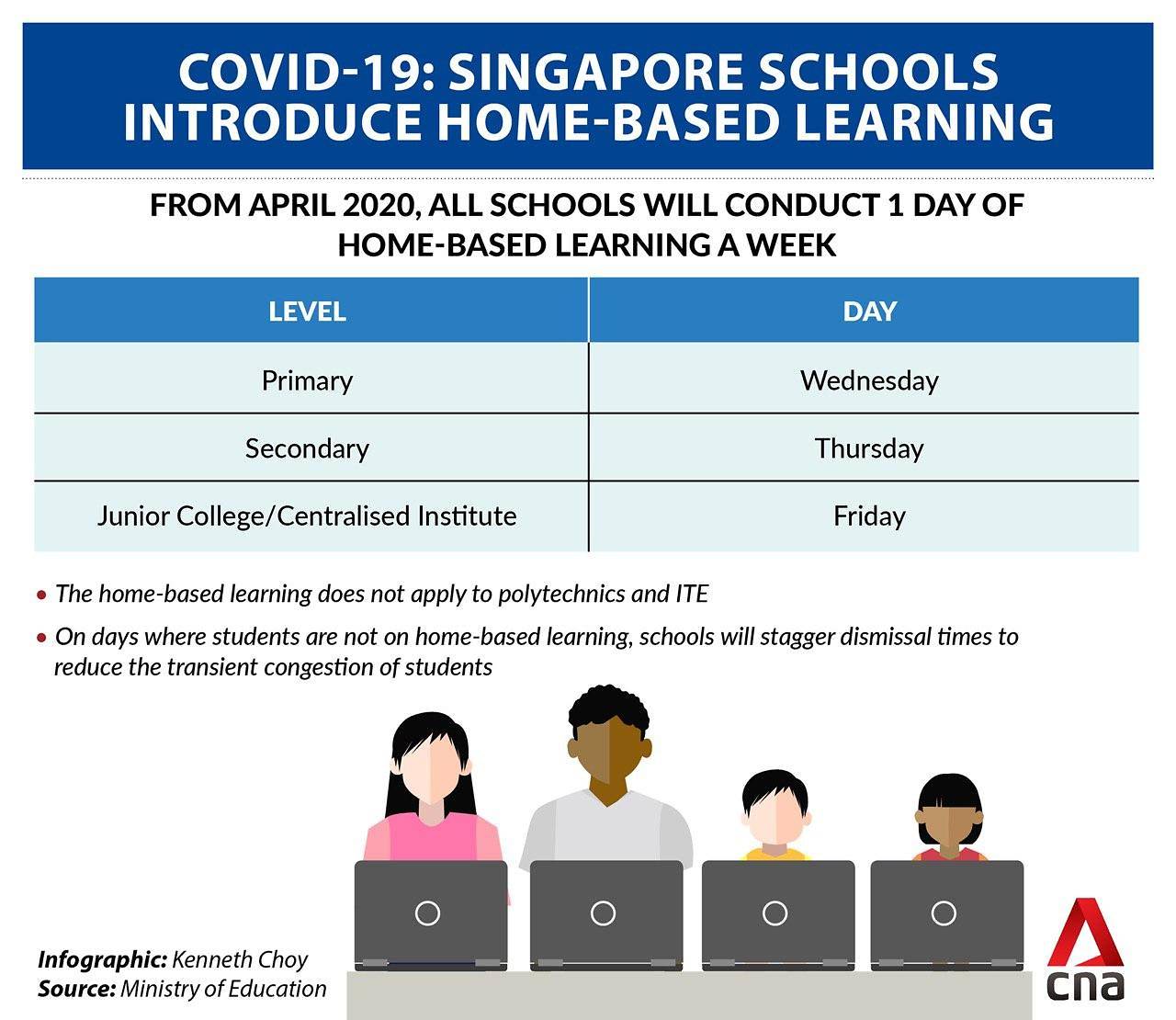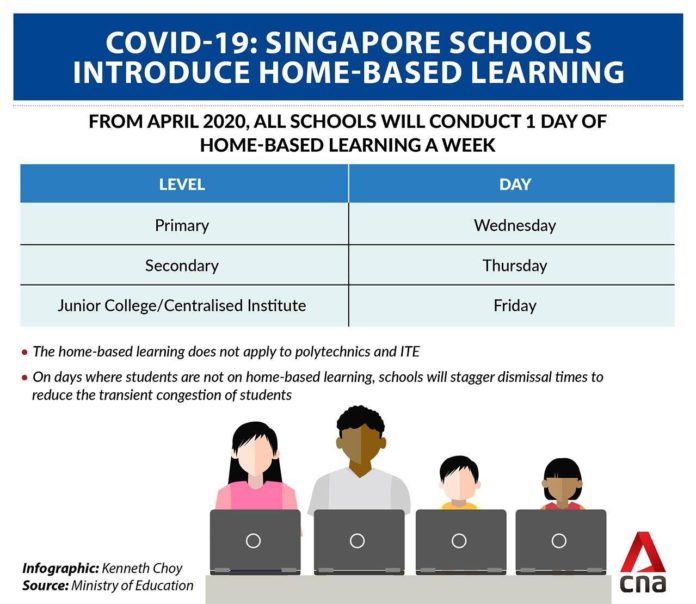SINGAPORE: Instead of donning his uniform to go to school on Wednesday (Apr 1) morning, Primary 5 student Danial Rizan completed his four hours of English, Mathematics, Science and Malay classes at home.
With Wednesday marking the first day of home-based learning for primary school students, most of them completed their assignments and learnt from home, working on hardcopy worksheets or online assignments on the Student Learning Space (SLS).
While he had some difficulties logging in and getting the audio for the video lessons to work, Danial said his experience with home-based learning has been smooth so far.
“The difference is in school, the teacher will guide us if we don’t know. We ask the teacher and the teacher will show us the answer,” said Danial.
“At home, we have nobody to ask. If our parents are (around), we may ask them for help,” said the 10-year-old Innova Primary School student.
Luckily, Danial’s mother is often around as she works from home. He said he consults her when he encounters topics not yet covered in school.
“She will sit beside me, but she will not tell me the answer. She will just explain this part, and then I will know (the answer) already,” he said.
Quizzes are the “fun part” of learning from home, said Danial, because he feels challenged to score better when he sees his friends’ scores.
The Ministry of Education (MOE) announced on Friday that all schools will conduct one day of home-based learning a week from April. The move was part of enhanced measures to stem the spread of COVID-19, after an increase in the number of imported and local cases here.
Primary schools will carry out home-based learning on Wednesdays, secondary schools on Thursdays, while junior colleges and centralised institutes will conduct them on Friday.
On days where students are not on home-based learning, schools will stagger dismissal times to “reduce the transient congestion of students”, said MOE.

Making the announcement on Friday, Education Minister Ong Ye Kung stressed that schools are not closing, but the new system will allow Singaporeans to “get used” to the idea of home-based learning and allow the ministry to expand the new system to more days, if necessary.
“Schools are not closing,” Mr Ong had told reporters on Friday.
“But what we have been working on is to prepare for some introduction of home-based learning.
“As the crisis develops, you will find that you have more arsenal, more measures to respond to as opposed to a sudden drastic change that will get everyone panicked, which is what we always want to avoid,” he added.
“TEETHING ISSUES” FACED, PARENTAL SUPPORT HELPFUL
For his home-based learning on Wednesday, Danial’s mother, Mdm Masliza Ismail received a schedule from the school with the designated hours for each subject and a summary of the homework assigned.
While students are given a week to complete the assignments and do not have to follow the timings strictly, Mdm Masliza said the schedule also helps Danial complete his work on time.
“He prefers to follow the timing because the earlier he finishes, the earlier he can rest. The timing will be like school, if he follows the hours,” she added.
“At home, at least they are free and easy but still learning. It’s just a different way.”
Being at home makes it easier for her to supervise or support Danial while he is learning, said Mdm Masliza, adding that working parents may face additional problems if their child needs help with the computer while they are at work.
When Danial was in lower primary, she was still working in an office and would bring him to the office on home-based learning days. At the time, she found that she was unable to concentrate at work because he would face login issues or have difficulties with the assignments.
She also said that starting with one day of home-based learning a week was a “good idea”, giving working parents time to make alternative arrangements before the programme was expanded.
In a Facebook post on Wednesday, Education Minister Ong Ye Kung noted “teething issues” when he visited Sembawang Primary School. About 20 students were present because their parents had to work or because they had no WiFi at home.
“Got feedback that some students at home also had problems logging into Student Learning Space (SLS),” he wrote. “Please bear with us as we iron out the tech glitches.”
Teachers also put in extra hours for home-based learning and there is “a lot of adjustment to be done”.
“It’s not easy and it’s not perfect, but we are tapping on our collective efforts to get this to work during such exceptional times,” said Mr Ong.
LEARNING FROM HOME AT SCHOOL
When CNA visited Innova Primary School on Wednesday, 39 students across lower and upper primary levels were in school to work on the same assignments as their level peers at home. Students were grouped in different classrooms according to level, with one row of tables between them for safe distancing.
About 80 students were given the option to come back to school for home-based learning, based on the knowledge that they did not have alternative care arrangements, access to WiFi at home or that they required additional help academically, said vice-principal Stephen Lau.
Innova Primary School students completing home-based learning assignments in school. (Photo: Ang Hwee Min)
Like Danial, some of them encountered issues logging on to SLS, but received help from teachers who were in the classrooms to guide students through the assignments. Other teachers remained at home to log students’ attendance, temperatures and monitor the students’ progress on the online modules.
For students who fail to log on to SLS, teachers will call their homes to check on them, said Mr Lau. Parents can also call the school to ask for IT support or help in explaining certain concepts to their children.
“Some students were not able to log in at the stipulated time. However, we have contingency in place – the students were also given written assignments to do.”
Mr Lau added that on Wednesday, the SLS system was down for “less than half hour” and the issue was resolved shortly after.
Schools did not have to start planning for home-based learning “from scratch” because it had been implemented before.
For example, home-based learning is implemented for the other levels during PSLE oral or on PSLE marking days, said Mr Lau, adding that parents are “familiar with the process”.
Students would receive a simplified timetable, with only four subjects – English, Mathematics, Mother Tongue and Science. According to Mr Lau, online and offline tasks are allocated two hours each.
Teachers can come up with different formats for home-based learning, including video lessons or online quizzes, said Mr Lau, adding that the school did not scramble to plan for the new measures announced on Friday.
“We plan for continuity, that means the scheme of work is still being followed. As far as possible, home-based learning will be a continuation of where the teacher left off,” he said.
Having a safe learning environment with curated resources is “very important”, said Ms Farlinah Supaah, head of the English department at Innova Primary. This would enable students to find the answers to their questions within the SLS, rather than go online or on social media to look for them.
“The children are not worried that they cannot do (the assignments). In fact, they like to see their responses posted up,” she said.
“I feel that I get more responses online because everybody is required to respond, versus in a face-to-face classroom where you have a limited amount of time to capture everyone’s learning. The responses from even our quieter students are captured.”
Having online lessons also allows children to build on each other’s ideas more seamlessly, said Ms Farlinah.
“Students can read someone else’s opinions and see if they can improve their own.”





